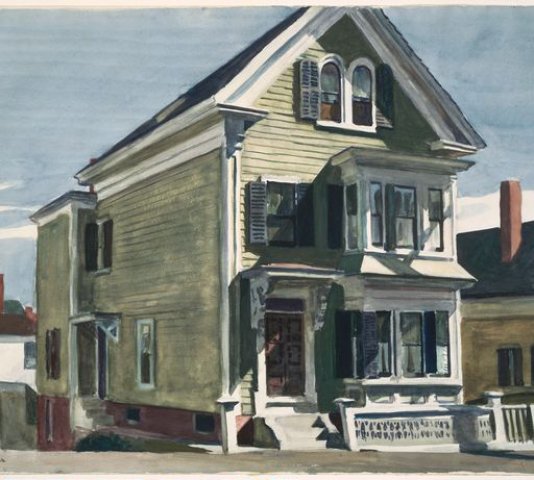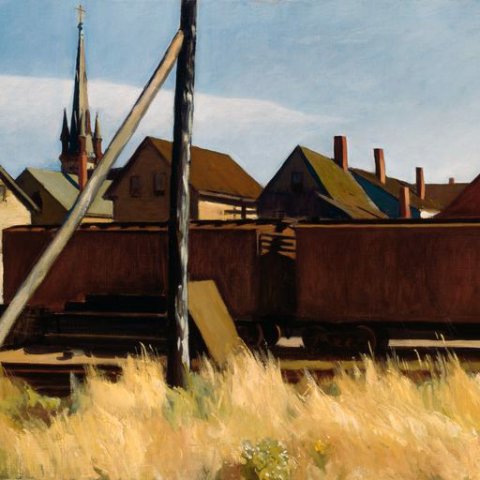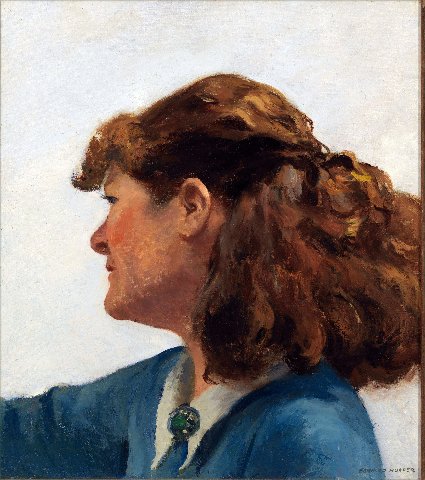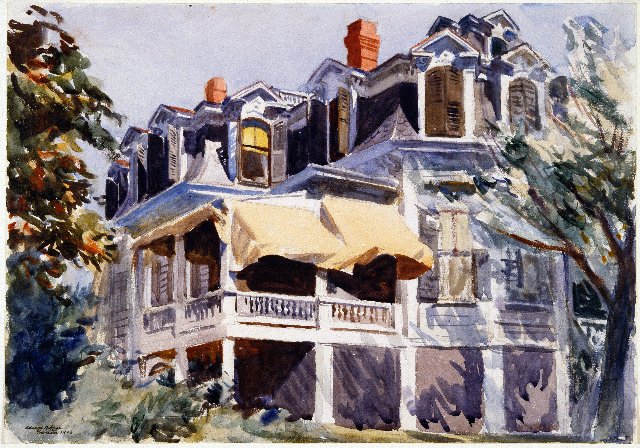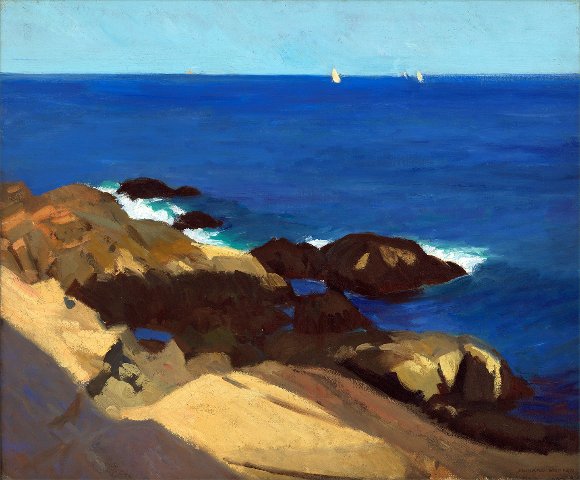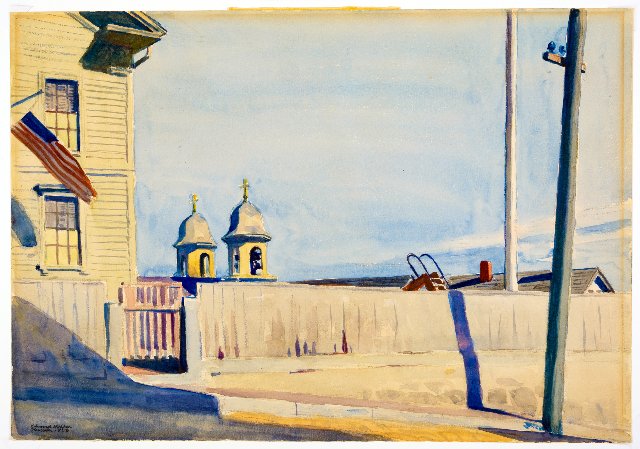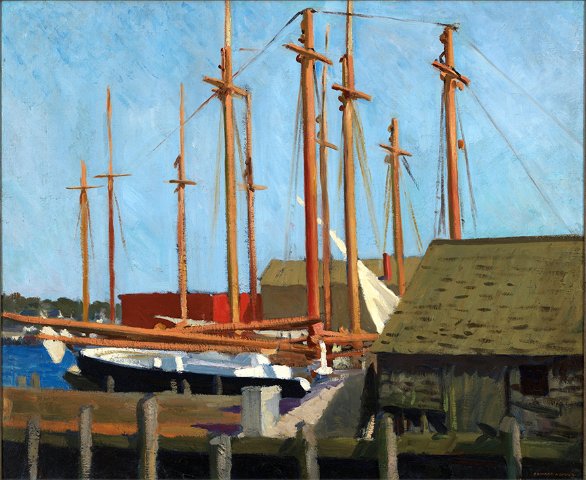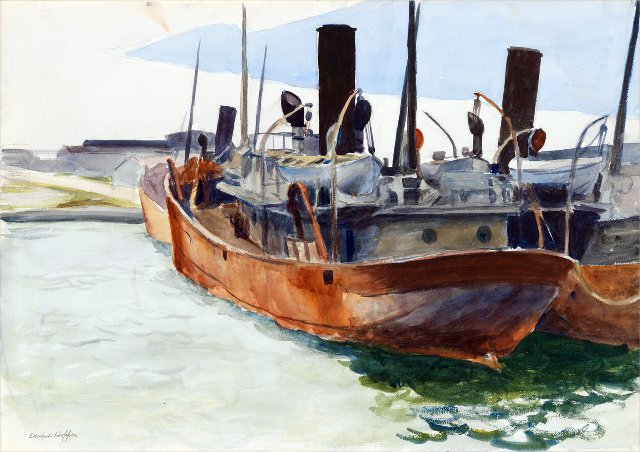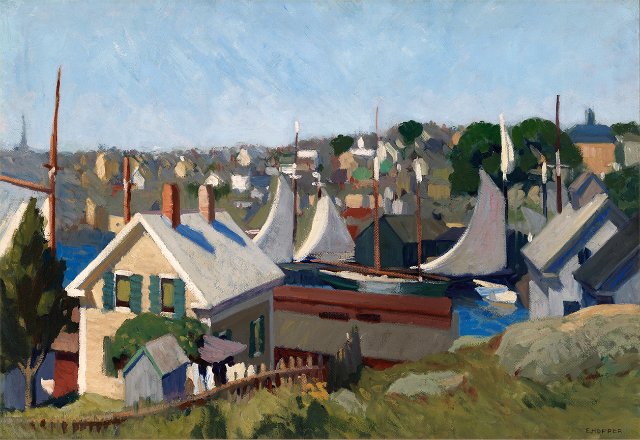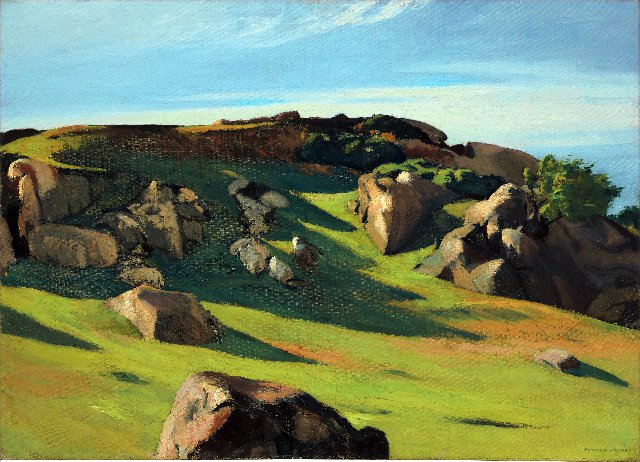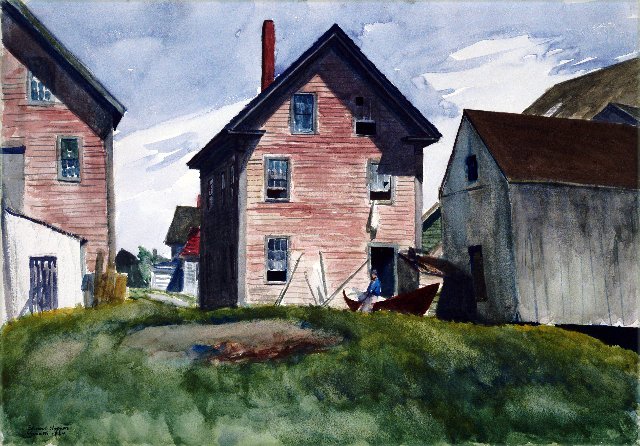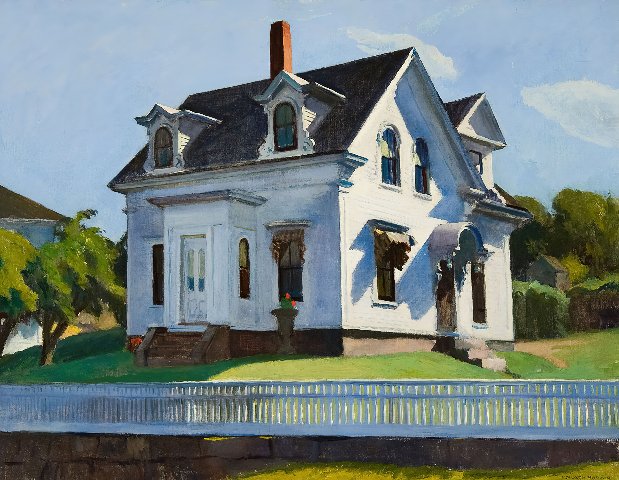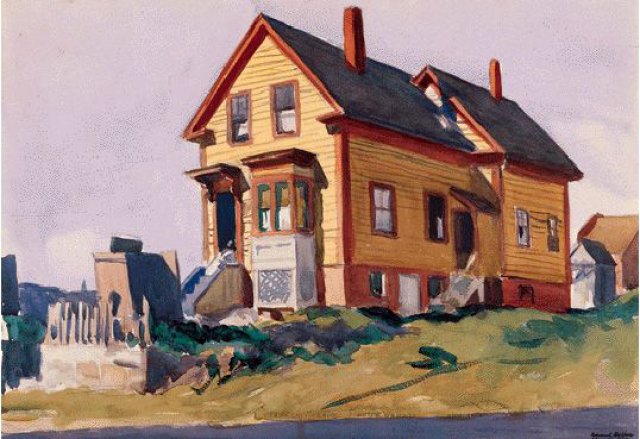Edward and Jo Hopper at Cape Ann Museum
Part of Glucester 400th Plus
By: Charles Giuliano - Apr 10, 2023
Edward Hopper (July 22, 1882 – May 15, 1967) is one of the most beloved and paradigmatic artists of his generation. He created an uninflected oeuvre of deadpan, realist scenes of
Unlike his peers during the Great Depression and WWII he seemed to advocate no causes or calls for social justice. He depicted poignant figures seemingly alone and introspective. One interprets that as the persona of the artist conveying a thoughtful, melancholy view of American life that most viewers readily relate to.
He loved cinema and a sense of film noir inhabits his 1941 masterpiece Nighthawks. With characters stopping for a late night cup of joe and slice of pie it reads like a movie still. Similarly, we admire and empathize with the beautiful blonde dressed as an usherette lost in thought in a gilded movie palace.
In urban paintings he depicts a nude midinette in a simple apartment staring out the window. Even an unpopulated work Early Sunday Morning, 1930, has an implicit narrative quality. It is a main street view of how I recall small town
There is a spare, protestant austerity to the work which is often most interesting for what it is not and refrains from revealing. He was trained in proletariat realism by Robert Henri who was a part of the Ashcan school which included John Sloan, Everett Shinn, William Glackens and others. Unlike them he was not drawn into socialism.
Being devoid of social justice content has proved to make the work more enduring. Work with strident political and class content undermines longevity. The social realism of the 1930s was rendered obsolete by the evolution of post war abstract expressionism. American Scene painters like Thomas Hart Benton and Grant Wood, or the evocative and raucous Reginald Marsh, were brushed aside as corny and dated by the mainstream critics and curators.
Today this long rejected work is coming back into the canon through a new generation of revisionist scholars and curators. In the cascading cycles of art history, old is new again.
Hopper’s reputation, however, never seems to have been laundered through the wash and dry of changed and evolving critical opinion. In the hearts and minds of American art, after years of struggle, by mid-career he was established and has remained entrenched.
On closer inspection there is much about the persona and work that is curious, contradictory, and quietly eccentric.
Early on, to earn a living, he was a freelance illustrator. It paid the bills but he hated this work. He made three trips to
In 1912, Hopper traveled to
Included in the legendary Armory Show of 1913 he sold his first painting Sailing (1911) for $250 to an American businessman Thomas F. Vietor. Hopper was then thirty-one. He continued to exhibit but it would be a decade before further sales.
In 1923 Hopper again summered in
A century later this is the focus of a special exhibition. It is a highlight of
What follows is the museum’s press release.
The
This major exhibition is the first dedicated to Hopper’s formative development on Cape Ann, marking the pivotal summer of 1923 when Edward Hopper and his future wife, Josephine “Jo” Nivison, visited
“This inaugural partnership with the Whitney Museum of American Art as a leading national institution is a first for the
The exhibition features 65 works including paintings, drawings, and prints brought together from the Whitney Museum of American Art, the Brooklyn Museum, the Museum of Fine Arts, Boston, National Gallery of Art, The Philadelphia Museum of Art and 23 other institutions and private lenders to tell the story of Hopper’s formative years when he experimented with his painting technique, met his future wife, and embarked on a legendary career. The exhibition includes 57 works by Edward Hopper, seven by Jo Hopper, and one by their teacher Robert Henri.
This once-in-a-generation exhibition, and the accompanying 224-page catalogue being published by Rizzoli Electa, are curated by nationally recognized curator and former museum director, Elliot Bostwick Davis, PhD. “Despite painting in Gloucester in 1912 and in Maine for six more summers, Hopper initially struggled to find a distinctive artistic voice,” writes Davis. “Hopper understood that
Edward Hopper (1882-1967) visited Cape Ann initially at the invitation of his friend and fellow painter, Leon Kroll (1884-1974), and produced his first oil painting outdoors in the
Hopper was seemingly drawn to Cape Ann for its ease by train from New York City and by the legendary light that captivated other artists – such as Fitz Henry Lane (1804-1865), William Morris Hunt (1824-1879), Winslow Homer (1836-1910), John Sloan (1871-1951), Theresa Bernstein (1890-2002), William Meyerowitz (1887-1981), and Stuart Davis (1894-1964) among others. On
In 1923, Josephine “Jo” Verstille Nivison (1883-1968) was an established artist, as well as an amateur actress and dancer, whose paintings had been accepted by the
Hopper took Nivison’s advice during their joint painting excursions. The result was Eastern Point Light (1923) followed by 17 more watercolors over eight weeks that summer including Deck of a Beam Trawler, 1923; Portuguese Church,
After Nivison and Hopper returned to New York in the fall of 1923, she lobbied for Hopper’s work to be included alongside her own in the second major biennial devoted to American watercolors at the Brooklyn Museum. The curators selected six of Hopper’s
By 1924, Hopper hoped Nivison would return to
“Hopper gives us an extraordinary opportunity to tell
Another major aspect of the Cape Ann Museum exhibition will be the accompanying 224-page catalog, published by Rizzoli Electa and due out May 2 in hard and softcover editions. This publication, which shares the exhibit’s title, Edward Hopper & Cape Ann, tells the largely ignored but significant origin story of Edward Hopper’s years in and around
This important partnership with Rizzoli Electa marks the first time that the
Edward Hopper & Cape Ann will be on view at the Museum’s Downtown Campus in
In preparation for Edward Hopper & Cape Ann the Museum during the 2022-2023 school year has been working with every eighth grader on
Timed- entry tickets will be required and go on sale at www.capeannmuseum.org on June 1, 2023. Admission, which includes both Edward Hopper & Cape Ann and general Museum entry is: Adults $23; Cape Ann Residents, Seniors, and Students: $18; Youth under 18: Free.
Edward Hopper & Cape Ann is made possible with thanks to a visionary anonymous gift and with additional leadership support provided by: Jackie and J. J. Bell, John and Mollie Byrnes, Catherine and Peter Creighton, Henrietta Gates and Heaton Robertson, Ann Rogers Haley and John F. Haley Jr., Ann T. and John Hall, Janet and William Ellery James, Stephen Kaloyanides, Littlejohn Family Foundation, Susie and Stanley Trotman, and the Wyeth Foundation for American Art, among others. This exhibition is supported by an indemnity from the Federal Council on the Arts and Humanities. In cooperation with the Whitney Museum of American Art, New York, the major repository of Hopper’s work.
Hopper exhibition photo credits
- Hopper catalogue.
- Anderson’s House, 1926
Museum of Fine Arts, Boston
Bequest of John T. Spaulding, 48.720
Photograph © 2023, Museum of Fine Arts, Boston
© 2023 Heirs of Josephine N. Hopper / Licensed by Artists Rights Society (ARS), NY
3 Italian Quarter, Gloucester, 1912
Whitney Museum of American Art, New York
Josephine N. Hopper Bequest, 70.1214
Digital image © Whitney Museum of American Art / Licensed by Scala / Art Resource, NY
© 2023 Heirs of Josephine N. Hopper / Licensed by Artists Rights Society (ARS), NY
4 Freight Cars, Gloucester, 1928
Oil on canvas, 29 x 40 1/8 in. (73.66 cm x 101.92 cm)
Addison Gallery of American Art, Phillips Academy, Andover, Massachusetts
Gift of Edward Wales Root in recognition of the 25th Anniversary of the Addison Gallery, 1956.7
Photo Credit: Addison Gallery of American Art
© 2023 Heirs of Josephine N. Hopper / Licensed by Artists Rights Society (ARS), NY
5 Jo Painting, 1936
Whitney Museum of American Art, New York
Josephine N. Hopper Bequest, 70.1171
Digital image © Whitney Museum of American Art / Licensed by Scala / Art Resource, NY
© 2023 Heirs of Josephine N. Hopper / Licensed by Artists Rights Society (ARS), NY
6 The Mansard Roof, 1923
The Brooklyn Museum, New York
Museum Collection Fund, 23.100
© 2023 Heirs of Josephine N. Hopper / Licensed by Artists Rights Society (ARS), NY
7 Josephine Nivison Hopper (1883-1968), Church Towers, Gloucester, 1923
Whitney Museum of American Art, New York
Bequest of Josephine N. Hopper
Digital image © Whitney Museum of American Art / Licensed by Scala / Art Resource, NY
© 2023 Heirs of Josephine N. Hopper / Licensed by Artists Rights Society (ARS), NY
8 Gloucester Beach, Bass Rocks, 1923-24
Watercolor, 11 x 17 1/2 in. (27.9 x 44.4 cm)
Private Collection
Image courtesy Christie’s
© 2023 Heirs of Josephine N. Hopper / Licensed by Artists Rights Society (ARS), NY
9 Briar Neck, Gloucester, 1912
Whitney Museum of American Art, New York
Josephine N. Hopper Bequest, 70.1193
Digital image © Whitney Museum of American Art / Licensed by Scala / Art Resource, NY
N.B. The correct spelling of this local landmark is Brier Neck.
© 2023 Heirs of Josephine N. Hopper / Licensed by Artists Rights Society (ARS), NY
10 Portuguese Church in Gloucester, 1923
Herbert F. Johnson Museum of Art, Cornell University
Gift of Sheila H. Hearne in memory of William L. Hearne, Class of 1924, for the Frank and Rosa
Rhodes Collection; 94.026.001
Image courtesy Johnson Museum
© 2023 Heirs of Josephine N. Hopper / Licensed by Artists Rights Society (ARS), NY
11 Tall Masts, 1912
Whitney Museum of American Art, New York
Josephine N. Hopper Bequest, 70.1198
Digital image © Whitney Museum of American Art / Licensed by Scala / Art Resource, NY
© 2023 Heirs of Josephine N. Hopper / Licensed by Artists Rights Society (ARS), NY
12 Trawler, 1923-24
Whitney Museum of American Art, New York
Josephine N. Hopper Bequest, 70.1092
Digital image © Whitney Museum of American Art / Licensed by Scala / Art Resource, NY
© 2023 Heirs of Josephine N. Hopper / Licensed by Artists Rights Society (ARS),
13 Gloucester Harbor, 1912
Oil on canvas, 26 3/8 x 38 5/16 in. (67 x 97.3 cm)
Whitney Museum of American Art, New York
Josephine N. Hopper Bequest, 70.1204
Digital image © Whitney Museum of American Art / Licensed by Scala / Art Resource, NY
© 2023 Heirs of Josephine N. Hopper / Licensed by Artists Rights Society (ARS), NY
14 Cape Ann Granite, 1928
Oil on canvas, 29 x 40 1/4 in. (73.5 x 102.3 cm)
Private Collection
Image courtesy Christie's
© 2023 Heirs of Josephine N. Hopper / Licensed by Artists Rights Society (ARS), NY
15 Gloucester Mansion, 1924
Museum of Fine Arts, Boston
Bequest of John T. Spaulding, 48.717
Photograph © 2023, Museum of Fine Arts, Boston
© 2023 Heirs of Josephine N. Hopper / Licensed by Artists Rights Society (ARS), NY
16 Hodgkin’s House, 1928
Oil on canvas, 28 x 36 in. (71.1 x 91.4 cm)
Private Collection
© 2023 Heirs of Josephine N. Hopper / Licensed by Artists Rights Society (ARS), NY
17 House in Italian Quarter
Smithsonian American Art Museum
© 2023 Heirs of Josephine N. Hopper / Licensed by Artists Rights Society (ARS), NY


